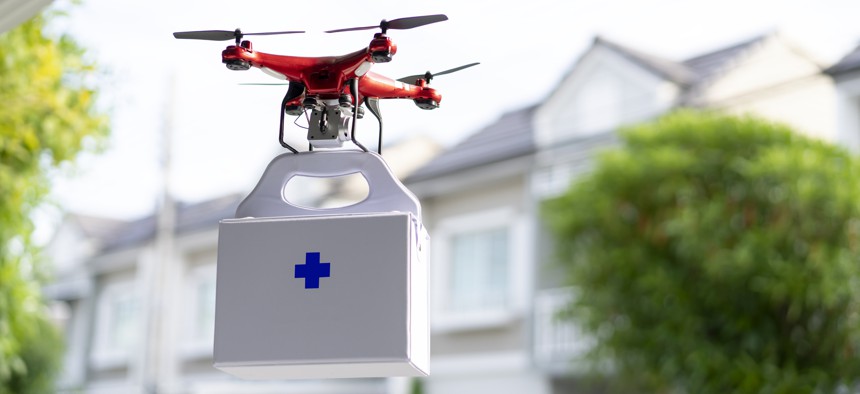One state maps out its drone-enabled future

seksan Mongkhonkhamsao/Getty Images
The Ohio Department of Transportation is testing its uncrewed traffic management system that would allow drones to operate at low altitudes beyond the operator's line of sight.
The Ohio Department of Transportation has released what it calls the nation’s first advanced air mobility (AAM) framework.
An initiative of DriveOhio, the state’s smart mobility hub, the framework aims to nurture the development of Ohio’s drone industry through research on enabling cargo and freight delivery, on-demand transportation between nearby cities and emergency response services.
The framework describes the existing unmanned aircraft ecosystem, Ohio-specific activities, route planning considerations and recommendations for establishing vertiports, officials said in a press statement. It also includes a strategic map for supporting the emerging drone industry in Ohio.
One of the drone industry’s enabling technologies is a ground based detect and avoid system that can track drones and keep them from colliding with each other as well as aircraft that operate at lower altitudes like medical helicopters or crop dusters.
An Uncrewed Traffic Management (UTM) system is being developed by a partnership that includes the Ohio Department of Transportation’s Office of Statewide Planning and Research, the Federal Aviation Administration, DriveOhio/FlyOhio, the Ohio Unmanned Aircraft Systems Center, Ohio State University and industry participants.
It relies on advanced signal processing technology, data optimized for UTM and three ground-based radar locations along the U.S. 33 Smart Mobility Corridor, a 35-mile stretch between Dublin and East Liberty in central Ohio. Data feeds are integrated with a UAS service supplier to schedule flights and manage traffic through a traffic operations center, according to the AAM framework.
Essentially, a drone operator would request clearance to fly and be given permission to use the airspace from the FAA. Both drone pilots and manned aircraft pilots would be able to see each other and safely share the airspace.
With the UTM, drones will be able to fly safely beyond the operator's line-of-sight without ground observers, which will allow delivery of packages of medical supplies and consumer goods.
“The last mile package delivery is what the future holds. The FedExs, UPSs, Amazons -- that two-hour delivery that they guarantee -- this technology will support that,” Richard Fox, airspace manager for the Ohio UAS Center, said in an ODOT release.
“The promise of drone deliveries has been around for some time, but that key infrastructure to support that has not existed,” said Matt McCrink, lead scientist for Ohio State’s research team. “ODOT is at the forefront of essentially establishing what that infrastructure looks like, how we can scale it, grow it, and incorporate it with the existing manned traffic control systems as well.”
The system was recently used as part of a multi-jurisdictional first responder training exercise that involved an overturned tractor trailer. The drones transmitted live video to emergency dispatchers, first responders and the ODOT Traffic Management Center in Columbus. When a medical helicopter was called to fly a victim to the hospital, the system alerted the drone operators so they could clear the airspace.
“As we learn how to do the smaller operations and manage the lower altitude airspace safe and efficiently for UAS, you’re going to see the industry grow,” said Sean Calhoun with CAL Analytics.
“Efforts to develop the right kind of infrastructure for drone technology through this cutting-edge system will promote safe practices and innovation in the sky, solidifying Ohio’s place as a leader in the advanced air mobility space,” said Lt. Gov. Jon Husted, director of InnovateOhio. “Not only does advanced air mobility have huge potential to improve the quality of life for Ohioans but supporting its growth can position us as a leader in an incredibly dynamic and innovative sector of the economy, helping us compete and win on the world stage.”






